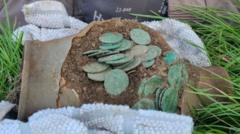Could the Discovery of 15,000 Roman Coins Be Wales' Biggest Treasure Ever?

Published: 2025-10-22 23:00:15 | Category: wales
A recent discovery by metal detectorist David Moss in North Wales has led to the unearthing of what could potentially be the largest hoard of Roman coins ever found in Wales, numbering between 10,000 and 15,000 coins. This extraordinary find not only has the archaeological community buzzing but also raises questions about treasure laws and the fate of such historical artefacts in the UK.
Last updated: 29 October 2023 (BST)
What’s happening now
David Moss, a 36-year-old metal detectorist from Cheshire, has made headlines after discovering two clay pots containing a staggering number of Roman coins. His find occurred in a "virtually untouched" area of North Wales and has drawn attention from experts, who believe it could be the largest hoard ever discovered in Wales. The coins are currently housed at the National Museum Cardiff for analysis, where they will be cleaned and dated. This discovery follows a long tradition of coin hoards being buried during periods of turmoil, often left behind by their owners in haste.
Key takeaways
- The coins were discovered by David Moss, who estimates the amount to be between 10,000 and 15,000.
- This find could surpass previous hoards discovered in Wales, including a 10,000-coin hoard found near Chepstow in the 1990s.
- The coins are currently being analysed by experts at the National Museum Cardiff.
Timeline: how we got here
David Moss's discovery was made in August 2023. The following is a brief timeline of significant events leading to this moment:
- August 2023: David Moss discovers two clay pots filled with Roman coins in North Wales.
- 2008: Nearly 6,000 Roman coins were uncovered in Sully, Vale of Glamorgan.
- 1990s: A hoard of 10,000 coins was discovered near Chepstow.
- 2010: Over 50,000 Roman coins were found in Somerset, valued at £320,250.
What’s new vs what’s known
New today/this week
The recent discovery of up to 15,000 Roman coins could redefine the understanding of Roman wealth in Wales. This hoard is being closely monitored by archaeologists and numismatists, with excitement building regarding its historical significance and potential value.
What was already established
Previous discoveries of Roman coins in Wales have highlighted the area's rich history. The hoard found in the 1990s near Chepstow remains the largest known until now. There are established protocols under the Treasure Act 1996 for reporting and valuing treasure finds, which will also apply to Moss's discovery.
Impact for the UK
Consumers and households
The discovery of such a significant archaeological find could lead to increased interest in local heritage, potentially boosting tourism in North Wales. This might translate into economic benefits for local businesses and communities as visitors flock to see the coins on display at the National Museum Cardiff.
Businesses and jobs
For the archaeological and museum sectors, this find may lead to new job opportunities in research, conservation, and public engagement. It could also encourage local businesses to collaborate with museums for educational tours and exhibitions.
Policy and regulation
The discovery will likely prompt discussions about the importance of treasure reporting laws in the UK. As the coins are evaluated, there may be a renewed focus on the legal frameworks guiding archaeological finds, particularly in terms of ownership and reward distribution.
Numbers that matter
- Estimated coins in the recent find: 10,000–15,000.
- Previous largest hoard in Wales: 10,000 coins near Chepstow.
- Number of Roman coins found in Sully in 2008: Nearly 6,000.
- Value of the Somerset hoard found in 2010: £320,250.
Definitions and jargon buster
- Treasure Act 1996: A UK law requiring that certain finds of gold, silver, or coins be reported to the authorities.
- Finds Liaison Officer: A designated individual responsible for advising on treasure finds and reporting processes.
- Numismatics: The study or collection of currency, including coins, tokens, and paper money.
How to think about the next steps
Near term (0–4 weeks)
The immediate focus will be on assessing the coins and determining their historical context. Experts will clean and date the coins, which could take several months.
Medium term (1–6 months)
Once the assessment is complete, the museum will notify David Moss and the landowner about the valuation and next steps regarding ownership and rewards.
Signals to watch
- Updates from the National Museum Cardiff regarding the assessment process.
- Any announcements related to changes in treasure reporting laws or policies.
Practical guidance
Do
- Report any finds to a Finds Liaison Officer within 14 days.
- Document the location and circumstances of the find thoroughly.
- Handle found coins carefully and avoid cleaning them to preserve their condition.
Don’t
- Do not conceal finds from the landowner or authorities.
- Avoid attempting to sell or trade items before they are legally assessed and valued.
Checklist
- Have I reported my find to a Finds Liaison Officer?
- Have I documented all relevant details about the find?
- Am I aware of the legal definitions of treasure?
- Have I avoided cleaning the artefacts?
Risks, caveats, and uncertainties
While David Moss's find is celebrated, it's crucial to note that not all discoveries lead to ownership or financial reward. The laws governing treasure in the UK are strict, and any perceived misconduct could lead to reduced rewards or legal consequences. Furthermore, the exact historical context of the coins remains uncertain until the analysis is complete.
Bottom line
The discovery of a potential 15,000 Roman coins in Wales marks a significant moment in the nation's archaeological narrative. As experts analyse the coins, the find could reshape our understanding of Roman presence in the area. For metal detectorists and treasure hunters, this serves as a reminder of the legal responsibilities tied to such discoveries and the importance of preserving history.
FAQs
What constitutes treasure in the UK?
In the UK, treasure includes objects at least 300 years old that are made of precious metal or groups of at least two coins meeting specific criteria.
What should I do if I find treasure?
If you find treasure, it must be reported to a Finds Liaison Officer within 14 days to avoid legal repercussions.
Will I receive a reward for my find?
Yes, if the find is classified as treasure, the finder may receive a reward based on its assessed value, shared with the landowner.



